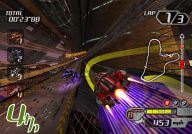
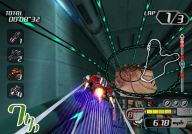
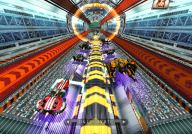
Tube
Slider is an impressive futuristic racer that is the initial comeback title for
legendary company NEC. Developed by NdCube, the game will please fans of F-Zero
with its fast, no-frills action. The game’s graphics are slick with cool ship
designs and it offers several modes of play including multiplayer action. Tube
Slider is somewhat derivative, but it is solidly implemented and challenging. Be
warned: the difficulty curve is steep, and this is probably the biggest hurdle
to enjoyment but persistence will be rewarded with an intense racing experience.
So, is this targeted to hardcore players only or can it appeal to all gamers? We
examine Tube Slider and find out.
After
nearly eight years of lying dormant, former TurboGrafx-16 manufacturer NEC has
made a welcome return the industry with the release of Tube Slider. This
futuristic racer features several different types of hovercraft. The designs on
these are impressive and each one has a unique set of strengths and weaknesses.
Each vehicle is ranked in a number of performance areas including speed,
acceleration, handling, and top speed. This is pretty standard but more
interestingly, each vehicle also has it’s own “Sub Vernier” which is how
much boost the vehicle can get from the power-ups. Finally, each ship has a
different size of Fuel Tank that determines how much power-up energy the vehicle
can hold. Once you have selected your vehicle, its time to determine which
racing mode you want to play. Tube Slider offers several modes of play including
free-run, time attack, training, versus and Grand Prix race modes. The Practice
Mode includes the Practice, Free Run and Time Attack modes. The last two allow
you to race against yourself on an empty field while the Practice mode places
velocity pick ups on the track that you need to run over successfully to
complete the practice mode. This helps you understand the physics better and get
a handle on how to control your ship. In the Grand Prix mode, you race for
points that are awarded based on your finishing position, and you must finish
all the races the Grand Prix in at least fourth place to progress to the next
rounds. Winning a tournament unlocks new tracks and ships which you can use in
the other modes. Additionally, Tube Sliders also offers a multiplayer Versus
mode where up to four players can compete simultaneously via a split screen.
This is nicely implemented and most of the time, all the players can clearly see
their position.
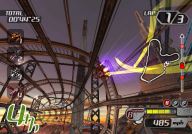 Tube Slider's racing is
straightforward because there are no weapons, just speed power-ups on the
tracks. This allows you to focus on the racing itself, which is intense and
quite difficult. While some players will undoubtedly find this streamlined
approach a bit barren, it makes it easier to concentrate without distractions.
One of the cool features of the game is the fact that the racing takes place
inside tubes that encircle the ships. These zero gravity chambers allow you to
race them from any angle: top, bottom, left and, right. However, certain sides
of the track enable the player to go faster. It’s not always obvious where
these speed zones are but you can follow the arrows for a good idea of where the
best routes are. The tracks themselves are straightforward and the main task is
to get through them as fast as possible. One of the biggest challenges in Tube
Sliders is to avoid spinning out during tight turns, which slows you down
significantly and can make you lose races almost automatically in the later
levels. To assist you on the tight corners, you can use your air brakes by
pressing down on the controller’s left and right shift buttons, this allows
you to take corners easier, but slows you down a bit. However, pressing both
shift keys simultaneously gives you a small speed boost.
Tube Slider's racing is
straightforward because there are no weapons, just speed power-ups on the
tracks. This allows you to focus on the racing itself, which is intense and
quite difficult. While some players will undoubtedly find this streamlined
approach a bit barren, it makes it easier to concentrate without distractions.
One of the cool features of the game is the fact that the racing takes place
inside tubes that encircle the ships. These zero gravity chambers allow you to
race them from any angle: top, bottom, left and, right. However, certain sides
of the track enable the player to go faster. It’s not always obvious where
these speed zones are but you can follow the arrows for a good idea of where the
best routes are. The tracks themselves are straightforward and the main task is
to get through them as fast as possible. One of the biggest challenges in Tube
Sliders is to avoid spinning out during tight turns, which slows you down
significantly and can make you lose races almost automatically in the later
levels. To assist you on the tight corners, you can use your air brakes by
pressing down on the controller’s left and right shift buttons, this allows
you to take corners easier, but slows you down a bit. However, pressing both
shift keys simultaneously gives you a small speed boost.
There are two basic types of speed power-ups: Turbo and Boost. You can only use
one type for each race, but you can switch between races. The power-ups work by
using a gauge at the lower left of the screen. As you play the game, it
gradually rises and you earn a boost when it’s fully charged. The boost gives
you a standard boost that lasts for a preset amount of time. The turbo mode
works a bit differently. You can enable its energy when the gauge reaches a
certain level, and you can continue to use the boost until the energy runs out.
Having two types of boost is a cool feature and each has its pluses and
minuses. Which one you’ll end up using depends on your playing style. In
addition to receiving power-ups from the icons and by waiting, you can lock on
to an enemies’ ship and drain their power-gauge. This is done by moving
directly behind an opponent’s vehicle and waiting for the lock-on indicator to
go on. This is a bit tricky, especially on corners which makes it harder to line
up your ship. Since a slight divergence out of the lock-on line means that you
have failed and must start the process again. However, the opposing ships can
lock onto your ship and drain your energy. To counter this, you can implement a
reverse lock-on by hitting your boost bar. This has the added benefit of letting
you sap the attacker’s energy. The game’s energy-based power-up system lends
Tube Slider a unique gameplay mechanic that adds to the challenge and strategy
of the race, making for some exciting race action.
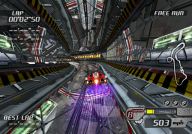 The
gameplay starts at a moderately fast pace but things get much more intense once
you reach the more advanced stages. The initial three-track competition is
deceptively easy to win, and serves as a good training primer for players to
master the basic techniques. For those who still need some help with the racing
action, the game includes an in-game tutorial, complete with short movies that
allow you to learn the basics without having to consult the manual. However,
once you get beyond the first track, things become much more difficult. The
second round requires you to race the same three tracks but, the opponent AI is
noticeably more aggressive, making rivals much harder to defeat. The rival
racers are a lot more aggressive, and frequently knock your ship to gain an
advantage. This steep difficulty curve makes subsequent races much harder to
win. It can be frustrating at first, but once you learn how to counter-attack
the other ships and avoid their advances, you’ll eventually be able to eke out
a few hard-earned wins. It quickly becomes obvious that Tube Slider’s
difficulty level is set a bit higher than other games in the genre, but the
challenge should give the game added appeal for the hardcore player. Casual
gamers will probably become frustrated in a hurry, but persistence pays off once
you unlock a second set of extra Maximum Class vehicles. The Maximum class craft
provide improved control, allowing the player to go much faster. Once you reach
this class, you’ll also unlock more tracks, which are a lot more interesting
and challenging than the initial training tracks with longer jumps and tighter
curves.
The
gameplay starts at a moderately fast pace but things get much more intense once
you reach the more advanced stages. The initial three-track competition is
deceptively easy to win, and serves as a good training primer for players to
master the basic techniques. For those who still need some help with the racing
action, the game includes an in-game tutorial, complete with short movies that
allow you to learn the basics without having to consult the manual. However,
once you get beyond the first track, things become much more difficult. The
second round requires you to race the same three tracks but, the opponent AI is
noticeably more aggressive, making rivals much harder to defeat. The rival
racers are a lot more aggressive, and frequently knock your ship to gain an
advantage. This steep difficulty curve makes subsequent races much harder to
win. It can be frustrating at first, but once you learn how to counter-attack
the other ships and avoid their advances, you’ll eventually be able to eke out
a few hard-earned wins. It quickly becomes obvious that Tube Slider’s
difficulty level is set a bit higher than other games in the genre, but the
challenge should give the game added appeal for the hardcore player. Casual
gamers will probably become frustrated in a hurry, but persistence pays off once
you unlock a second set of extra Maximum Class vehicles. The Maximum class craft
provide improved control, allowing the player to go much faster. Once you reach
this class, you’ll also unlock more tracks, which are a lot more interesting
and challenging than the initial training tracks with longer jumps and tighter
curves.
It
takes a few laps to fully understand all the racing techniques but, controlling
the vehicles should present little problem since the controls are easy to
understand. Vehicle response time is fluid though you have to slow down a bit
when taking corners unless you want to slide out into the wrong direction, which
can be frustrating. The turbo boost functions are integrated into the controls
as is the energy lock-on system. The in-game HUD is transparent, allowing you to
see your position and turbo boost status without interfering with the gameplay. The
game’s soundtrack features the obligatory techno tracks that fit the feel of
the game nicely, but don’t offer much to distinguish Tube Slider from the many
other futuristic racers on the market. From a visual standpoint, the game looks
sharp and crisp with excellent ship and course designs lending the game a unique
personality. You can see the F-Zero influence in the game’s overall design but
the unique cylindrical tracks give the game a unique feel that makes you feel
like you’re gliding on air. It moves at a fast clip and the object renderings
range from good to great with some truly inspired areas punctuated by many bland
sections. Most of the tracks take you through closed-in areas but things get
interesting when the action moves to open spaces. These sections allow you to
see the ship suspended in midair with large, open environments surrounding it.
Unfortunately, several behind the ship viewpoints are offered, but the lack of a
first-person mode is disappointing. On the other hand, the perspective doesn’t
change when you move to the side or the top of the track, which helps somewhat
in reducing the dizziness that these games offer. The game’s engine moves at a
smooth clip and shows off the Gamecube’s processing powers.
 While
Tube Slider’s presentation and controls seem derivative of F-Zero on the
surface, this is mitigated by elements in the design that give it a unique feel.
The tube courses are impressive in design and the ability to race anywhere makes
for some fun play mechanics. The ability to lock on and drain power from your
opponents is also an interesting twist. Controlling the vehicles is intuitive
with seamless controls. Tube Slider’s visuals are also excellent and highly
polished, though some tracks suffer from a strong sense of déjà vu. However,
the ship designs are creative and imaginative, and many break the standard
futuristic mold, giving Tube Slider a unique visual look. The biggest issue the
game has is its difficulty – it starts easily, but things become much harder
in a hurry. The difficulty is bound to turn off some players, and those looking
for something they can master should look elsewhere. However, those who turn it
off early on are missing out, as the later levels become much faster and more
intense than the relatively tame early races. So, while the casual player will
find that it becomes too frustrating too early, those gamers looking for a
challenge will definitely get their money’s worth. Despite some minor
problems, Tube Slider is a solidly entertaining racing game that tests your
skills and persistence. While its not revolutionary, there are some excellent
ideas in the game that make it a worthwhile purchase for fans of the genre. Tube
Slider marks a promising rebirth for NEC and hopefully a taste of things to come
from the company.
While
Tube Slider’s presentation and controls seem derivative of F-Zero on the
surface, this is mitigated by elements in the design that give it a unique feel.
The tube courses are impressive in design and the ability to race anywhere makes
for some fun play mechanics. The ability to lock on and drain power from your
opponents is also an interesting twist. Controlling the vehicles is intuitive
with seamless controls. Tube Slider’s visuals are also excellent and highly
polished, though some tracks suffer from a strong sense of déjà vu. However,
the ship designs are creative and imaginative, and many break the standard
futuristic mold, giving Tube Slider a unique visual look. The biggest issue the
game has is its difficulty – it starts easily, but things become much harder
in a hurry. The difficulty is bound to turn off some players, and those looking
for something they can master should look elsewhere. However, those who turn it
off early on are missing out, as the later levels become much faster and more
intense than the relatively tame early races. So, while the casual player will
find that it becomes too frustrating too early, those gamers looking for a
challenge will definitely get their money’s worth. Despite some minor
problems, Tube Slider is a solidly entertaining racing game that tests your
skills and persistence. While its not revolutionary, there are some excellent
ideas in the game that make it a worthwhile purchase for fans of the genre. Tube
Slider marks a promising rebirth for NEC and hopefully a taste of things to come
from the company.
> Related Reviews
HSX: Hypersonic Xtreme (PS2)
Wipeout Fusion
(PS2)
Kinetica (PS2)
Pulse Racer (Xbox)
Quantum Redshift (Xbox)

